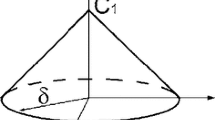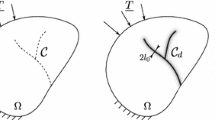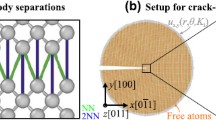Abstract
A general theory of kinetic crack growth in ideally brittle solids is developed from first principles. In setting up a basic model, emphasis is placed on the essential need to provide for the existence of an energy barrier to activated, non-linear crack motions at the atomic level. The picture is presented of an ideally brittle fracture crack in which sequential bond rupture occurs via the lateral motion of atomic kinks along the crack front. Approximate solutions to the equations of kink motion are then obtained from the discrete, “lattice trapping” theory of Thomson and co-workers. Assuming a classical distribution of kink sites, an expression for the steady-state crack velocity follows. A feature of the present theory is the formulation in terms of the fundamental energy-balance concept of Griffith, with two major advantages: in the first place, standard fracture-mechanics parameters, such as the mechanical-energy-release rate and the fracture-surface energy, enter into the description in a natural manner; in the second, the effect of extrinsic agents on activated kink motion is readily accountable, through a simple modification of the total energy function for the crack system. To illustrate the model, the case of a slowly growing brittle crack in the presence of an interacting ideal gas environment is treated in some detail.
Similar content being viewed by others
References
H. H. Johnson and P. C. Paris, Eng. Fract. Mech. 1 (1968) 3.
S. M. Wiederhorn, “Fracture Mechanics of Ceramics”, Conference Proceedings, edited by R. C. Bradt, D. P. H. Hasselman and F. F. Lange (Plenum, New York, 1974) p. 613.
R. Thomson, Ann. Rev. Mat. Sci. 3 (1973) 31.
B. R. Lawn and T. R. Wilshaw, “Fracture of Brittle Solids” (Cambridge University Press, Cambridge, 1975), Chs. 7 and 8.
A. A. Griffith, Phil. Trans. Roy. Soc. Lond. A221 (1920) 163.
E. Orowan, Nature 154 (1944) 341.
R. Thomson, C. Hsieh and V. Rana, J. Appl. Phys. 42 (1971) 3154.
C. Hsieh and R. Thomson, ——ibid 44 (1973) 2051.
J. E. Sinclair and B. R. Lawn, Proc. Roy. Soc. Lond. A329 (1972) 83.
A. Kelly, W. R. Tyson and A. H. Cottrell, Phil. Mag. 15 (1967) 576.
J. R. Rice and R. Thomson, ——ibid 29 (1974) 73.
S. M. Wiederhorn, B. J. Hockey and D. E. Roberts, Phil. Mag. 28 (1973) 783.
E. Orowan, Rep. Prog. Phys. 12 (1949) 48.
G. I. Barenblatt, Adv. Appl. Mech. 7 (1962) 55.
J. R. Rice, J. Appl. Mech. 35 (1968) 379.
J. E. Sinclair, J. Phys. C: Solid State 5 (1972) L271.
Idem, Phil. Mag., in press.
S. M. Wiederhorn, J. Amer. Ceram. Soc. 55 (1972) 81.
S. M. Wiederhorn and H. Johnson, ——ibid 56 (1973) 192.
R. J. Charles and W. B. Hillig, “Mechanical Strength of Glass and Ways of Improving it”, Symposium Proceedings (Union Scientifique Continentale du Verre, Charleroi, Belgium, 1962) p. 511.
S. M. Wiederhorn, “Mechanical and Thermal Properties of Ceramics”, edited by J. B. Wachtman, Jun, (N.B.S. Special Publication 303, 1969) p. 217.
A. R. C. Westwood, J. Mater. Sci. 9 (1974) 1871.
B. R. Lawn, Mat. Sci. Eng. 13 (1974) 277.
R. N. Stevens and R. Dutton, ——ibid 8 (1971) 220.
S. M. Wiederhorn, Int. J. Fract. Mech. 4 (1968) 171.
W. L. Bragg and G. F. Claringbull, “Crystal Structures of Minerals” (Bell, London, 1965) Ch. 6.
R. Thomson and E. Fuller, “Fracture Mechanics of Ceramics”, Conference Proceedings, edited by R. C. Bradt, D. P. H. Hasselmad and F. F. Lange (Plenum, New York, 1974) p. 283.
A. J. Markworth, M. F. Kanninen and P. C. Gehlen, “Stress Corrosion Cracking and Hydrogen Embrittlement of Iron Base Alloys”, Conference Proceedings, edited by R. W. Staehle et al. (National Association of Corrosion Engineers, Houston, in press).
Author information
Authors and Affiliations
Additional information
On study leave, from School of Physics, University of New South Wales, Kensington, New South Wales, Australia.
Rights and permissions
About this article
Cite this article
Lawn, B.R. An atomistic model of kinetic crack growth in brittle solids. J Mater Sci 10, 469–480 (1975). https://doi.org/10.1007/BF00543692
Received:
Accepted:
Issue Date:
DOI: https://doi.org/10.1007/BF00543692




